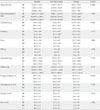1. Li Z, Hong K, Saltsman P, DeShields S, Bellman M, Thames G, Liu Y, Wang HJ, Elashoff R, Heber D. Long-term efficacy of soy-based meal replacements vs an individualized diet plan in obese type II DM patients: relative effects on weight loss, metabolic parameters, and C-reactive protein. Eur J Clin Nutr. 2005. 59:411–418.
2. Colditz GA, Willett WC, Rotnitzky A, Manson JE. Weight gain as a risk factor for clinical diabetes mellitus in women. Ann Intern Med. 1995. 122:481–486.
3. American Diabetes Association. Standards of medical care in diabetes--2010. Diabetes Care. 2010. 33:Suppl 1. S11–S61.
4. Ledikwe JH, Ello-Martin JA, Rolls BJ. Portion sizes and the obesity epidemic. J Nutr. 2005. 135:905–909.
5. Rolls BJ, Morris EL, Roe LS. Portion size of food affects energy intake in normal-weight and overweight men and women. Am J Clin Nutr. 2002. 76:1207–1213.
6. Pedersen SD, Kang J, Kline GA. Portion control plate for weight loss in obese patients with type 2 diabetes mellitus: a controlled clinical trial. Arch Intern Med. 2007. 167:1277–1283.
7. Hebert JR, Ma Y, Clemow L, Ockene IS, Saperia G, Stanek EJ 3rd, Merriam PA, Ockene JK. Gender differences in social desirability and social approval bias in dietary self-report. Am J Epidemiol. 1997. 146:1046–1055.
8. Rolls BJ, Roe LS, Halverson KH, Meengs JS. Using a smaller plate did not reduce energy intake at meals. Appetite. 2007. 49:652–660.
9. Ministry of Health and Welfare. The Korean national health nutrition examination survey 2005. 2007. Seoul: Ministry of Health and Welfare.
10. Ahn HJ, Koo BK, Jung JY, Kwon HR, Chung MY, Ku YH, Kim JT, Han KA, Min KW. Association between volume of bowls and the dietary intakes in subjects with type 2 diabetes. Korean Diabetes J. 2009. 33:335–343.
11. Ahn HJ, Eom YK, Han KA, Kwon HR, Kim HJ, Park KS, Min KW. The effects of small sized rice bowl on carbohydrate intake and dietary patterns in women with type 2 diabetes. Korean Diabetes J. 2010. 34:166–173.
12. Korean Diabetes Association. A guideline for diabetes education. 2006. 2nd ed. Seoul: Gold Agency.
13. Klein S, Sheard NF, Pi-Sunyer X, Daly A, Wylie-Rosett J, Kulkarni K, Clark NG. American Diabetes Association. North American Association for the Study of Obesity. American Society for Clinical Nutrition. Weight management through lifestyle modification for the prevention and management of type 2 diabetes: rationale and strategies: a statement of the American Diabetes Association, the North American Association for the Study of Obesity, and the American Society for Clinical Nutrition. Diabetes Care. 2004. 27:2067–2073.
14. Ello-Martin JA, Ledikwe JH, Rolls BJ. The influence of food portion size and energy density on energy intake: implications for weight management. Am J Clin Nutr. 2005. 82:1 Suppl. 236S–241S.
15. Kral TV, Roe LS, Rolls BJ. Combined effects of energy density and portion size on energy intake in women. Am J Clin Nutr. 2004. 79:962–968.
16. Steyn NP, Senekal M, Norris SA, Whati L, Mackeown JM, Nel JH. How well do adolescents determine portion sizes of foods and beverages? Asia Pac J Clin Nutr. 2006. 15:35–42.
17. Korean Diabetes Association. Staged diabetes management. 2007. 3rd ed. Seoul: Korean Diabetes Association;3–9.
18. Cho JW. The present status of diabetes education and opinion research of food exchange list. Korean Diabetes J. 2008. 32:Suppl 2. S109–S114.
19. Ahn HJ, Han KA, Kwon HR, Koo BK, Kim HJ, Park KS, Min KW. Small rice bowl-based meal plan versus food exchange-based meal plan for weight, glucose and lipid control in obese type 2 diabetic patients. Korean Diabetes J. 2010. 34:86–94.
20. Wilson C, Brown T, Acton K, Gilliland S. Effects of clinical nutrition education and educator discipline on glycemic control outcomes in the Indian health service. Diabetes Care. 2003. 26:2500–2504.
21. Kim SH, Kang ES, Park SY, Lee SJ, Kim MJ, Yoo JS, Ahn CW, Cha BS, Lim SK, Lee HC. The effects of lifestyle modification on the metabolic parameters of type 2 diabetes. J Korean Diabetes Assoc. 2004. 28:441–451.
22. Khan MA, St Peter JV, Breen GA, Hartley GG, Vessey JT. Diabetes disease stage predicts weight loss outcomes with long-term appetite suppressants. Obes Res. 2000. 8:43–48.









 PDF
PDF ePub
ePub Citation
Citation Print
Print


 XML Download
XML Download